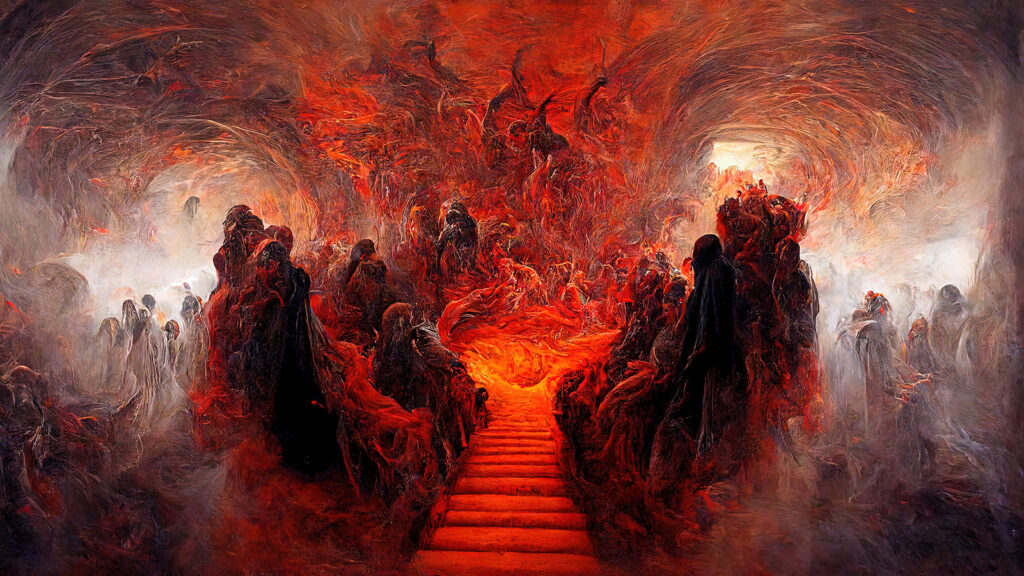
The hell inferno metaphor, souls entering to hell in mesmerize fluid motion, with hell fire and smoke
Demons have long captured the imaginations of cultures around the world, serving as symbols of chaos, destruction, and temptation. A recent exploration delves into the intricacies of these supernatural beings, revealing their roles across various mythologies and beliefs. From ancient deities transformed into malevolent spirits to fallen angels embodying pride, this ranked list showcases 25 of the most notorious demons historically blamed for humanity’s woes.
The Dark Legacy of Lucifer
At the forefront of this exploration is Lucifer, the most infamous of the fallen angels. Once regarded as God’s most radiant creation, his pride led to rebellion and subsequent banishment. Cast into the abyss, Lucifer became the ruler of Hell, embodying temptation and moral corruption. In Christian theology, he represents the dangers of pride, often depicted as both an angel and a serpent, reflecting his complex character across various cultural interpretations.
Other Notable Demons in Folklore
Another significant figure is Asmodeus, a demon rooted in Jewish demonology. Known for his three heads and dragon mount, Asmodeus governs desire and mischief, often manipulating human weaknesses, particularly in matters of gambling and lust. He appears prominently in texts like The Lesser Key of Solomon, where his influence on human behavior is detailed.
Equally compelling is Astaroth, a once-revered goddess turned duke in Christian demonology. Often depicted with a serpent, dragon, and scepter, Astaroth is known for offering wisdom in exchange for loyalty. This transformation highlights how cultural power dynamics shift over time, reflecting the malleable nature of deities and demons alike.
In the hierarchy of Hell, Bael, depicted with three heads—human, toad, and cat—commands legions and possesses the ability to grant invisibility. This marquis of Hell exemplifies the blurred lines between authority and monstrosity found in many demonological accounts. Similarly, Belial stands out as a master manipulator, promoting lawlessness and lust. His character serves as a chilling reminder of the consequences of moral decay.
Diverse representations of demons continue with Pazuzu, a wind demon from Mesopotamian lore. With a lion’s head and scorpion tail, Pazuzu brings both disease and protection from other malevolent entities, embodying the duality of supernatural beings. Then there is Moloch, notorious for his association with fire and sacrifice, representing the extremes of religious corruption, including the horrifying rituals involving child sacrifice.
The demon of greed, Mammon, is another figure of interest, tempting humanity with material wealth and highlighting the dangers of avarice. His portrayal in Christian theology serves as a cautionary tale about the spiritual ruin that can accompany the pursuit of riches.
In the realm of deception, Valefar promotes theft and betrayal, appearing as a knight-like figure riding a donkey. His character illustrates how close relationships can be undermined by dishonesty. Conversely, Furfur, a Great Earl of Hell, embodies elemental chaos, conjuring storms and lightning while speaking only lies unless summoned correctly.
Other notable demons include Marchosias, a former loyal angel yearning to return to Heaven, and Phenex, a flaming bird who teaches the arts but represents temptation through intellectual pride. Raum, depicted as a crow, is notorious for causing emotional destruction and influencing love, while Naberius uses his cunning speech to manipulate leaders and tempt pride.
The roster continues with Amy, a prince who reveals deep cosmic secrets and teaches various sciences. Dantalion, known for controlling human thoughts and emotions, reflects fears of manipulation by unseen forces. Andras, a knight of wrath, embodies violence and discord, while Vine bridges the worlds of battle and architecture, symbolizing power dynamics in the underworld.
Among the more intriguing figures is Gremory, a duchess of Hell who influences love and reveals hidden treasures, and Orobas, who stands out for his honesty among demons. Despite his noble character, Orobas serves as a reminder that not all who appear trustworthy are so.
The exploration concludes with Glasya-Labolas, a demon who revels in chaos and bloodshed, and Gaap, who embodies chaos and change, wielding the power to ignite both love and hatred. Finally, Malphas represents betrayal, showcasing how alliances can crumble under the weight of deception.
This comprehensive examination of demons reveals their complex roles in shaping human fears and behaviors throughout history. Each figure reflects a unique aspect of the human condition, serving as cautionary tales about the darker sides of ambition, desire, and morality. As societies evolve, so too do the stories surrounding these supernatural beings, ensuring their place in cultural narratives for generations to come.







